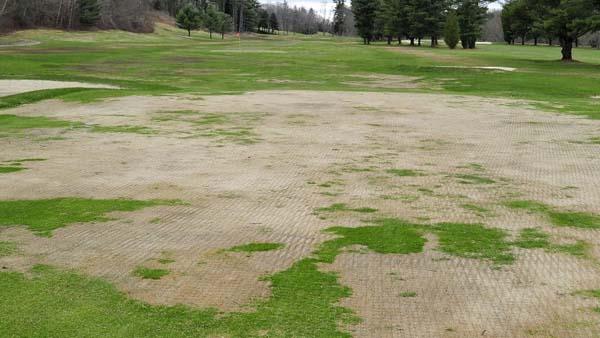
Not all winter damage on golf course turf is created equally.
Damage caused by harsh winter conditions typically is a concern throughout the Northeast and much of the Midwest, but what causes it and its severity can vary from location to location and year to year. And this year is no different, with superintendents in some areas reporting minor damage and others calling this year's damage the worst they've seen.
Now that spring finally has arrived, the USGA Green Section recommends adequate moisture on areas where turf is damaged but still alive, slit seeding those areas with weakened turf and reducing or eliminating traffic until such areas are repaired. A leading university researcher suggests reseeding severely affected areas with creeping bentgrass followed by a strict fertility program.
At James Baird State Park Golf Course in Pleasant Valley, New York, 16 of 18 greens were lost to winter kill, a problem that kept the course closed into May. The same can be said for The Golf Course at Yale in New Haven, Connecticut, where superintendent Scott Ramsay, CGCS, called the damage the worst he has seen in his 31 years as a superintendent.
According to the USGA Green Section, there were several different causes for winter damage, including rain followed by freezing conditions in December and January that left exposed and dormant turf covered in ice for an extended period. At James Baird, an ice storm that rolled through Pleasant Valley in mid-January was to blame.
Copious amounts of snow in other areas left turf blanketed in snow so long that suffocation was a concern. Then later in March, turf in areas where standing water is a concern went through the thaw-freeze cycle. For other courses along the coast, wind was the problem, first removing snow cover and then blowing over exposed dry and dormant turf, resulting in desiccation.
While Green Section agronomists recommend reviewing programs and procedures, they acknowledge there is really little any golf course superintendent can do to prevent winter damage, other than to repair areas where standing water is a recurring problem.
That's the route Ramsay took at The Golf Course at Yale in New Haven, Connecticut, where he said winter damage could have been much worse if not for a fall aerification treatment that prevented standing water from accumulating in low areas on greens.
The story is the same on Long Island, where long and persisting winter conditions have resulted in delayed course openings, tournament postponements and temporary greens, according to published reports. Normal playing conditions at many courses, especially those with annual bluegrass putting surfaces, are not expected until summer.
As usual, courses with predominantly bentgrass greens fared better than those touting mostly annual bluegrass, which is the area's primary putting surface.
In December, Kevin Frank, Ph.D., of Michigan State University delivered a seminar on winterkill during the annual Ohio Turfgrass Foundation conference and trade show.
The ability to recover depends entirely on the level of damage incurred, but such programs often begin with seeding bentgrass. Frank discussed
One such recovery program Frank discussed at OTF included seeding with bentgrass, followed by a starter fertilizer application at 0.75 pounds of phosphorus per 1,000 square feet, followed by a foliar program of 0.10 pounds of nitrogen per 1,000 applied every four to five days through mid- to late May. That program also included delaying PGR use until mid-June.
Properly preparing the area for seeding to improve seed-soil contact also played a critical role in how quickly an area recovered.
Frank has had a lot of experience lately helping superintendents from throughout the Midwest deal with the aftermath of winter damage. Damage from harsh winter conditions throughout Michigan was worst in 2014, but was more widespread this year, he said.
A year ago, winter damage was concentrated mostly in the Detroit area, while this year courses northward into the state's thumb all the way to Gaylord are reporting dead or damaged turf. At least three courses in the Detroit area have filed documents in court against The Travelers Indemnity Co. for denying insurance claims associated with winter damage.

